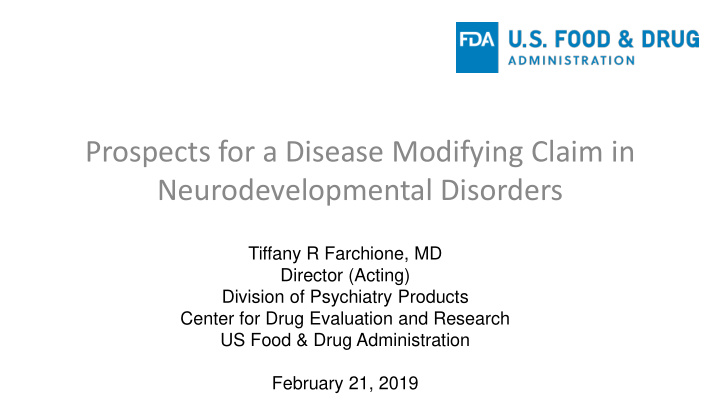



Prospects for a Disease Modifying Claim in Neurodevelopmental Disorders Tiffany R Farchione, MD Director (Acting) Division of Psychiatry Products Center for Drug Evaluation and Research US Food & Drug Administration February 21, 2019
Disclaimer • This presentation reflects the views of the author and should not be construed to represent FDA’s views or policies. 2
When Last We Met… • Presentation to ISCTM in 2014 – Dr. Robert Levin outlined FDA’s perspective on disease-modifying claims for schizophrenia – Outlined several definitions of disease modification – Proposed a “gold standard” – Provided examples of disease modification claims in several non- psychiatric illnesses – Described some study designs with potential for evaluating disease modification claims So, where are we now? www.fda.gov 3
Since 2014 • No drugs approved with disease modifying claims in psychiatry • To my knowledge, no studies have been conducted using a delayed start design for any psychiatric indication • No broad Agency guidance on disease modification www.fda.gov 4
Challenges for Disease Modifying Claims in Psychiatry • As outlined by Dr. Levin in 2014: – What are the pathophysiological processes? – Is it a progressive disease or illness? Course, trajectory, rate? Heterogeneous clinical courses and probably heterogeneous underlying pathophysiology, at different phases of illness – Progression in everyone or subgroups? Identify patients & groups who will deteriorate. – Which aspects of D/O and DZ are progressive? Positive Sx, Negative Sx, Cognitive impairment (specific), general deterioration of functioning or specific functional impairments? – When to study progression? How long to study? – What type of study designs? www.fda.gov 5
Challenges for Disease Modifying Claims in Psychiatry • Primary issue: What is the disease? – DSM defines syndromes , not diseases – Relationship between symptoms and pathophysiology poorly understood www.fda.gov 6 Image: American Psychiatric Association
Simplified Model of Humans and Diseases • Human is a collection of interacting biological components • Genes, regulatory networks, cells, organs • Certain changes in a component’s state changes the component’s functioning • Change in function at the component level may be observable as a change in function at the organism level 7
What Makes a Disease Modifiable? • A component that can undergo a state change – Anatomical structure – Cell structure – Gene sequence – Gene regulatory network • Disease manifestations – Symptom (change in function at a point in time) – Course (change in function over time) • Relational elements – Connections or links between state changes and manifestation – Relations represent causality and not just co-occurrence www.fda.gov 8
Healthy and Disease States when Disease Etiology is Related to a Single Component Healthy organism Component state Component function Symptom Disease, mild Disease, severe Component state Component state Component function Component function Symptom Symptom 9
Key Elements of This Model • The relationships between component state and component function, and between component function and symptoms, are causal relationships, not just co-occurrence • Our state of knowledge about these relationships is a key element in designating a drug’s action as disease modification • Observation of a change in syndrome course, in the absence of an understanding of the underlying mechanism of symptom causation, is insufficient for a disease modification claim ‒ This is a clarification in our thinking since the 2014 ISCTM presentation www.fda.gov 10
Neurodevelopmental Disorders • Multiple aspects of development usually affected • Complex pathophysiology – More than 1000 genes have been associated with autism spectrum disorder – Fragile X Syndrome caused by single gene mutation, but results in complex pattern of physical and intellectual changes • Potential effects of disease modifying treatments depend on both the nature and the timing of the intervention www.fda.gov 11 Image: Centers for Disease Control and Prevention
www.fda.gov 12
Trial Designs to Assess Disease Modification Claims • Withdrawal Design – Subjects randomized to active treatment followed by placebo (A/P) vs. placebo followed by placebo (P/P) P/P A/P Worsening Baseline Improving Period 1 Period 2 www.fda.gov 13
Trial Designs to Assess Disease Modification Claims • Randomized Delayed Start – Subjects randomized to 1) active treatment followed by active treatment or 2) placebo followed by active treatment www.fda.gov 14 Image adapted from Dr. Turkoz’s presentation
Addressing a Moving Target Typical Development Intervention Withdrawn Disease Modification? Development Maybe…Maybe Not Neurodevelopmental Disorder Intervention Time www.fda.gov 15
How to Interpret Withdrawal? Symptomatic patient Patient after treatment Drug affects Component state Component state underlying component Component function Component function Symptom Symptom vs. Symptomatic patient Patient after treatment Component state Component state Component function Component function Drug affects some other Symptom Symptom part of the system 16
Addressing a Moving Target Typical Development Not disease modifying? Or not the right time? Development Neurodevelopmental Disorder Intervention Time www.fda.gov 17
Conclusions • Approach to disease modification is fairly consistent across review divisions • In psychiatry, considerations of disease modification are limited by our understanding of pathophysiology • Observation of a change in syndrome course is insufficient for a disease modification claim • We propose a framework emphasizing the relationship between disease components and manifestations • Programs seeking a disease modification claim for treatment of a neurodevelopmental disorder face additional challenges www.fda.gov 18
Acknowledgements • Billy Dunn, MD – Director, Division of Neurology Products • Nikolay P. Nikolov, MD – Clinical Team Leader, Division of Pulmonary, Allergy, and Rheumatology Products • David Millis, MD, PhD, MBA ‒ Medical Officer, DPP • Javier A. Muniz, MD ‒ Associate Director of Therapeutic Review, DPP • Michael Davis, MD, PhD ‒ Clinical Team Leader, DPP • Zimri Yaseen, MD ‒ Medical Officer, DPP www.fda.gov 19
Recommend
More recommend